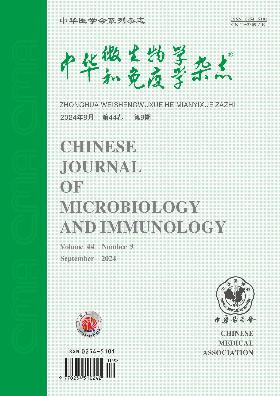新型冠状病毒(SARS-CoV-2)抗体检测试剂盒的性能评价及临床应用
Q4 Immunology and Microbiology
引用次数: 1
摘要
目的评价3种新型冠状病毒(SARS-CoV-2)抗体试剂盒的性能,探讨其临床应用的可行性和优势。方法选择2020年1 - 2月广州市第八人民医院收治的新冠肺炎患者104例为研究组。同期选取健康受试者51人作为阴性对照组。采用2种胶体金试剂盒(A、B)和1种化学发光试剂盒(C)检测血清抗SARS-CoV-2抗体(IgM/IgG)。回顾性分析不同病例标本中SARS-CoV-2核酸阳性率。结果A试剂盒检测sars - cov -2特异性IgM和IgG的临床敏感性分别为77.88%(81/104)和65.38%(68/104),临床特异性分别为70.59%(36/51)和100.00%(51/51)。而IgM检测的假阳性率高达29.41%(15/51)。B试剂盒检测SARS-CoV-2总抗体的敏感性为63.46%(66/104),临床特异性为94.12%(48/51)。C试剂盒检测sars - cov -2特异性IgM和IgG的临床敏感性分别为31.73%(33/104)和64.42%(67/104),临床特异性均为98.04%(50/51)。两种胶体金试剂盒的检测结果与化学发光试剂盒的Kappa值分别为0.462和0.587 (Z=6.157, P<0.01;Z = 7.345, P < 0.01)。C试剂盒IgG阳性检出率最高,在发病14 d后用于COVID-19患者IgG检测更为可靠。各类标本核酸总检出率为63.46%(66/104)。咽拭子和痰液检出率最高,其次是血液和肛门拭子。尿样暂未检出病毒核酸。结论在COVID-19早期和晚期均可检测到sars - cov -2特异性抗体。抗体检测方法具有检测时间短、操作简单、生物安全性高等优点,可作为核酸检测阴性的疑似病例诊断的补充或辅助检测。化学发光试剂盒具有良好的敏感性和特异性,推荐用于临床实验室。关键词:SARS-CoV-2;化学发光免疫测定;胶体金免疫法;核酸检测;绩效评估;临床应用本文章由计算机程序翻译,如有差异,请以英文原文为准。
Performance evaluation and clinical application of three antibody test kits for novel coronavirus (SARS-CoV-2)
Objective
To evaluate the performance of three antibody kits for novel coronavirus (SARS-CoV-2) and to investigate the feasibility and advantages of them in clinical application.
Methods
A total of 104 patients who were admitted to Guangzhou Eighth People's Hospital with COVID-19 from January to February 2020 were selected as research group. Fifty-one healthy subjects were selected during the same period as negative control group. Serum antibodies (IgM/IgG) against SARS-CoV-2 were detected using two kinds of colloidal gold kits (A and B kits) and one chemiluminescence kit (C kit). The positive rates of SARS-CoV-2 nucleic acid in different samples from patients with COVID-19 were retrospectively analyzed.
Results
The clinical sensitivity of A kit to detect SARS-CoV-2-specific IgM and IgG was 77.88% (81/104) and 65.38% (68/104), respectively, and the clinical specificity was 70.59% (36/51) and 100.00% (51/51). However, the false positive rate in IgM detection was as high as 29.41% (15/51). The sensitivity of B kit to test total antibodies to SARS-CoV-2 was 63.46% (66/104), and the clinical specificity was 94.12% (48/51). The clinical sensitivity of C kit to detect SARS-CoV-2-specific IgM and IgG were respectively 31.73% (33/104) and 64.42% (67/104), and the clinical specificity were both 98.04% (50/51). There was a moderate correlation between the detection results of two colloidal gold kits and the chemiluminescence kit with the Kappa values of 0.462 and 0.587 (Z=6.157, P<0.01; Z=7.345, P<0.01). C kit had the highest positive detection rate for IgG, and would be more reliable to be used for IgG detection in COVID-19 patients 14 d after onset. The total positive detection rate of nucleic acid in all types of samples was 63.46% (66/104). The highest positive detection rate was in throat swabs or sputum samples, followed by those in blood samples and anal swabs. No viral nucleic acid was detected in urine samples for the time being.
Conclusions
SARS-CoV-2-specific antibodies could be detected in the early or late stage of COVID-19. The method of antibody detection has the advantages of shorter detection time, simple operation and high biological safety, indicating that it could be used as a supplementary or auxiliary detection for the diagnosis of suspected COVID-19 cases with negative nucleic acid test results. The chemiluminescence kit has good sensitivity and specificity, and is well recommended for clinical laboratories.
Key words:
SARS-CoV-2; Chemiluminescence immunoassay; Colloidal gold immunoaasay; Nucleic acid detection; Performance evaluation; Clinical application
求助全文
通过发布文献求助,成功后即可免费获取论文全文。
去求助
来源期刊

中华微生物学和免疫学杂志
Immunology and Microbiology-Virology
CiteScore
0.50
自引率
0.00%
发文量
6906
期刊介绍:
Chinese Journal of Microbiology and Immunology established in 1981. It is one of the series of journal sponsored by Chinese Medical Association. The aim of this journal is to spread and exchange the scientific achievements and practical experience in order to promote the development of medical microbiology and immunology. Its main contents comprise academic thesis, brief reports, reviews, summaries, news of meetings, book reviews and trends of home and abroad in this field. The distinguishing feature of the journal is to give the priority to the reports on the research of basic theory, and take account of the reports on clinical and practical skills.
 求助内容:
求助内容: 应助结果提醒方式:
应助结果提醒方式:


